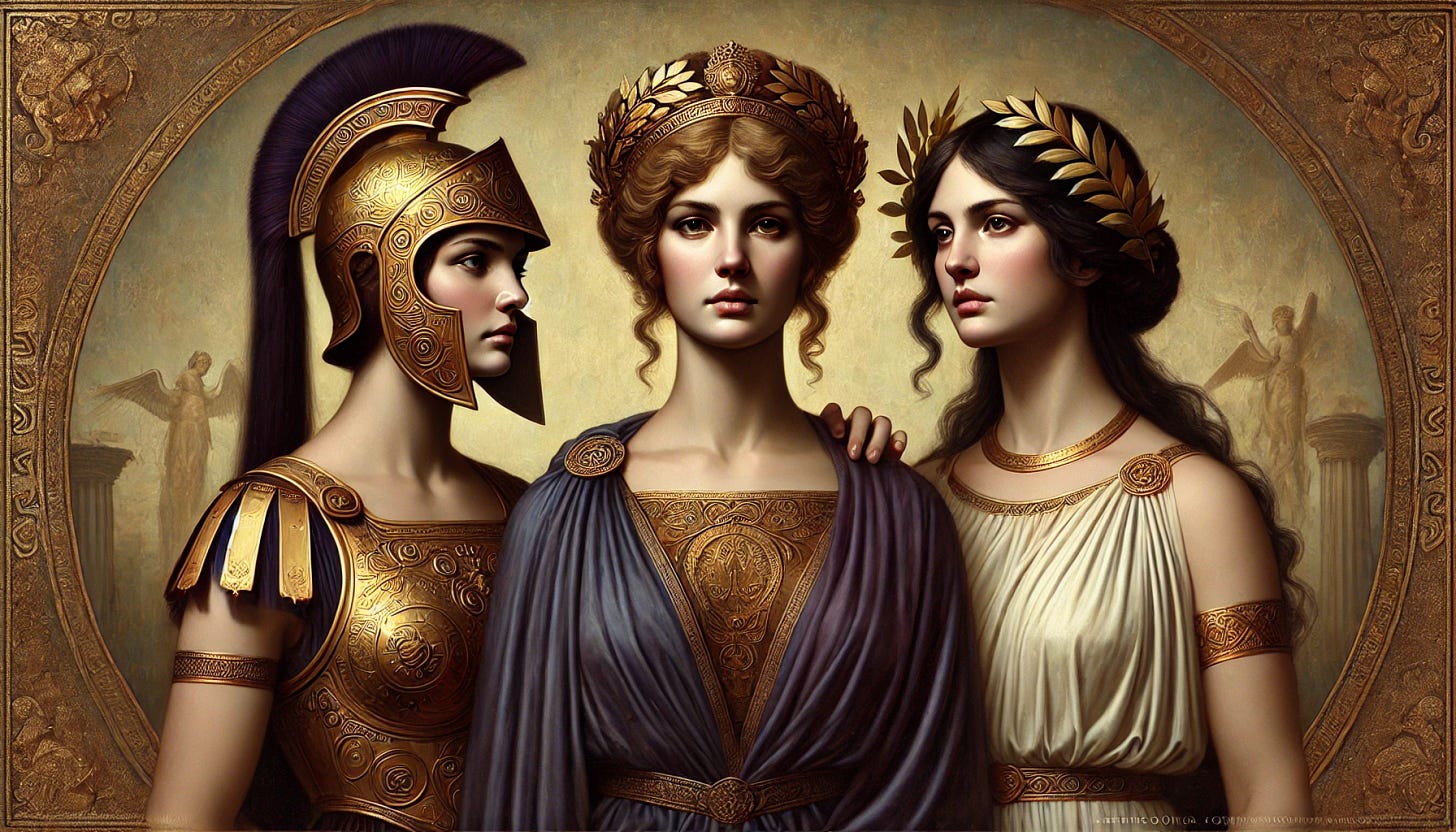The Sky-Veil: Goddesses and Saints
On the Distinction Between the Goddesses and Saints in the Sky-Veil
Important Companion Reads
In the mythopoetic cosmology of The Sky-Veil, the figures of Aphrodite, Athena, and Hera are understood not as predicates—qualities or attributes assigned to a subject—nor as metaphysical entities with independent existence. Rather, they are thresholds of presence, veiled unveilings, and symbolic harbingers of the clearing of transformative Being that transcend simple description. We are the clearing for this transformation, and they are the heralds portending the unveiling of beauty, wisdom, and majesty.
They are not predicates, because they are more than concepts or qualities;
they are not metaphysical entities, because they are less than personal beings. They are the manner in which the world presents itself to us, unveiled from metaphysical masking that covers over and “forgets” the being-ness of beings and conceals the clearing in our existence.
The goddesses serve as poetic mediators between the mundane and the meaningfully transformative, between metaphysical beings and the Being of beings hidden beneath the ideas and concepts. They do not exist as beings within the order of creation, nor do they dwell in the Communion of Saints. Instead, they function as resonances, remembrances of the divine, presenting through beauty, wisdom, and majesty in the symbolic imagination. They are not worshipped, but contemplated as shimmering heralds. They do not intercede, but rather orient the soul toward encounter with that which is holy.
By contrast, the saints in Heaven are metaphysical persons—each a unique soul, fully alive in the beatific vision of God. They are subjects, not symbols; beings, not metaphors. Their glory is not allegorical, but real, rooted in their sanctified union with Christ. The saints are partakers of the Divine Life, radiant with grace, and active participants in the Communion of Saints. They are intercessors, companions, and heirs of the Kingdom.
Thus:
The goddesses are threshold figures—liminal, poetic, and symbolic. They are expressions of Being-ness encountered through the imagination, art, and myth, pointing toward the divine but not possessing it.
The saints are redeemed persons—ontologically real, spiritually glorified, and eternally alive in God. They no longer point toward the divine; they dwell within it.
In this cosmology, the goddesses occupy the veil between mundane “forgetting” and the clearing of transformative “remembrance.” As glittering lights in our world, they assist the pilgrim through and across it—the Sky-Veil. The saints are those who have passed to the Grove Beyond in the Kingdom of God. The goddesses draw our attention to an openness for encounter with beauty, wisdom, and divine order; the saints are fulfilled in these resonances and share their treasures with us. The goddesses stir longing; the saints are filled with the Beloved.
The epithets “grey-eyed,” “ox-eyed,” and “laughter-loving” are used throughout this work as mythopoetic titles expressing the refulgence of Joan of Arc’s sanctity through the lens of the heralds of the Sky-Veil. Drawn from ancient invocations of Athena (grey-eyed), Hera (ox-eyed), and Aphrodite (laughter-loving), these names are not attributed to Joan in the mythological or metaphysical sense of identification with pagan deities. Rather, they are artistic gestures that evoke the triune poetic light of beauty, wisdom, and majesty—unfolded in ancient myth and transfigured in Joan’s being through her union with Christ. Joan is the rose, the living flame, the crown of the heralds through her heavenly life in Christ.
In the Sky-Veil cosmology, these epithets represent hypostatic nearness—thresholds of Being’s self-disclosure through symbol. They are not predicates or possessions, but poetic unveilings. The “grey-eyed Being” of Joan announces her contemplative clarity and martial courage in the light of divine wisdom. The “ox-eyed” gaze unveils the majestic stillness and sovereign bearing that crowns her mission. The “laughter-loving” joy evokes the radiant charity and divine beauty suffused in her soul. Together, they mark Joan not as a mythic figure reborn, but as a saint in whom ancient longing is fulfilled, and through whom Being, once veiled in symbol, now shines forth in grace.
The Sky-Veil is a work of sanctification: as Pope Gregory counseled not to burn the pagan temples but to cleanse and reorient them to Christ, so too this mythopoesis does not destroy the beauty of the Hellenic imagination, but purifies and transfigures it. Aphrodite, Athena, and Hera no longer receive worship as goddesses; instead, they stand as heralds through the Veil, bearing forward the radiance of Being toward its fulfillment in Catholic truth.




